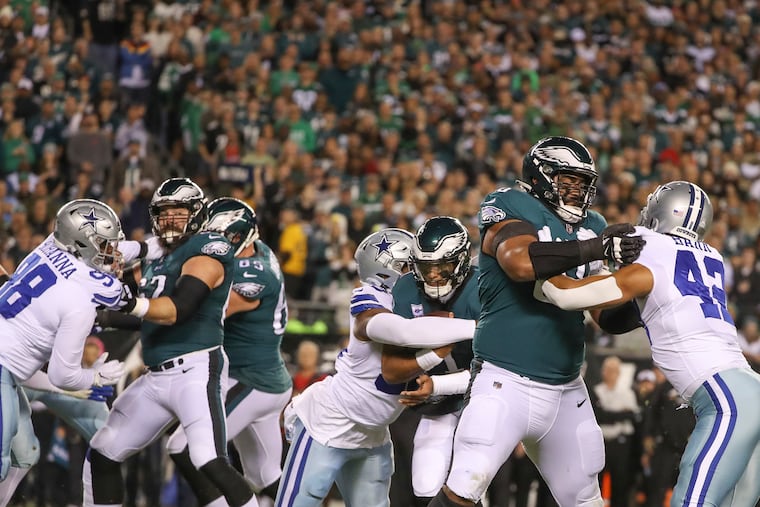The Eagles are outsmarting and demoralizing the rest of the NFL by going old-school
Opposing teams know the Eagles are going to run the ball, especially late in a game. They just can't do anything to stop it.

Early Monday morning, in a Lincoln Financial Field locker room that was rapidly emptying, Jordan Mailata took time to savor just how much he and his teammates along the Eagles’ offensive line had emasculated the Dallas Cowboys’ defense. The clinching drive in the Eagles’ 26-17 victory Sunday night had been a monster: 13 plays and 75 yards for a touchdown. But 10 of those plays had been runs, at a time — early in the fourth quarter — when an offense protecting a slim lead is expected to run the ball, when it should be harder for an offense protecting a slim lead to run the ball.
Sure enough, the Cowboys knew the Eagles would run the ball. They even knew how they’d run it. Damn if they could stop it.
“It was kind of amazing,” Mailata said. “They were calling out some of the runs and some of the passes, but they were just tired.”
What the Eagles have developed here, really, is a secret weapon that isn’t a secret. For all the complaints over the years — from Andy Reid to Doug Pederson, from Chip Kelly to even Nick Sirianni early on last season — about the Eagles’ throwing the ball too much, this year they can run the ball, and they do the run the ball. They lead the NFL in rushing attempts (225) and are fifth in rushing yards (936). On the whole, they’re not especially efficient; their yards-per-carry average, 4.2, is 23rd-best among the league’s 32 teams. But in four of their six games this season — at Detroit and Arizona, against Jacksonville and Dallas — they were able either to salt away a victory or fashion a winning drive largely by having Jalen Hurts hand the ball off or carry it himself.
» READ MORE: ‘Like a hovercraft’: Lane Johnson’s mastery on film as analyzed by Eagles O-line coach Jeff Stoutland
“Our bread-and-butter is the inside zone,” Mailata said. “Everyone knows it. The league knows it. It’s what we practice every day. It’s our fundamentals. We do the same drills every day because we go back to the fundamentals — until somebody stops us. Then we adjust. And you know what the funny thing is? They know it. They call it. And they still can’t stop it. It’s crazy.”
That ability, to run the ball when running the ball is predictable, is a powerful weapon for the Eagles to wield, and it’s one of the big reasons that they’re 6-0 now and will be a difficult team to beat over their final 11 regular-season games. They have the quarterback to do it. They have the offensive line to do it — though that line will be hampered if Lane Johnson has to miss significant time because of his concussion. And, most interestingly, they can employ and are employing this strategy at a time when it is primed to work.
As more and more teams have built their offenses around their quarterbacks and their passing games, as more and more teams rely on concepts that were once consigned to college football — the spread, first and foremost — defenses have adjusted over time. One of the primary adjustments they’ve made, as Pro Football Focus’ Seth Galina pointed out last year, is to play more nickel. That is, instead of playing a traditional alignment with three linebackers, they’re more frequently taking a linebacker off the field and replacing him with a defensive back.
“In 2020,” Galina wrote, “only one-quarter of all defensive snaps were played with three linebackers on the field. That is the lowest rate in any of the 15 years of PFF data.”
Now, a team with a great quarterback and/or great receivers might not fear such an adjustment, and it might throw the ball anyway, because that’s what its offense is built to do. But if a defense is choosing to be smaller and faster, then an offense, in turn, can be bigger and stronger and flex its muscles, either by choice or necessity.
The Atlanta Falcons are an ideal example of the latter approach. They have a turnover-prone quarterback in Marcus Mariota and just one elite pass-catcher in tight end Kyle Pitts. It hasn’t taken long for Arthur Smith, their second-year head coach, to figure out that they aren’t going to win many games by having Mariota drop back 35-40 times a game. So the Falcons are instead pounding opponents with a terrific running game. They’re second to the Eagles in rushing attempts (202), third in yards (991), and ninth in yards per attempt (4.9), and despite having Matt Ryan chew up more than $40 million worth of dead money against their salary cap, despite the expectations that they’d be among the league’s worst teams, they’re 3-3 and tied for first in the NFC South.
The Eagles aren’t the Falcons. They have A.J. Brown and DeVonta Smith and Dallas Goedert and Quez Watkins and Zach Pascal, and as good as their running attack has been, they’re sticking to the same formula that has been a staple of their offensive philosophy since Reid was here: Throw the ball to get the lead; run the ball to protect it. Take their first game and their latest. Against the Lions, 17 of their first 25 offensive plays were called passes. Against the Cowboys, 14 of their first 20 offensive plays were.
In other words, the Eagles have options, and even when most of those options fail, they can still rely on what everyone knows is coming and what no one has yet been able to stop. There’s nothing more demoralizing to an opponent, and nothing more encouraging about what is possible for this team.